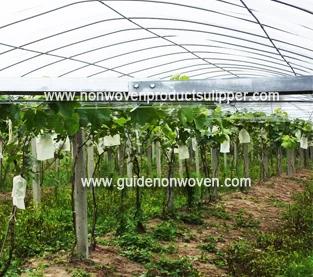The use of non-woven fabrics in agriculture in various countries
(A)
cover material
Spring and autumn in Europe, climate complex. Plants in a glass conservatory affect their growth due to frost, which can cause serious death. The traditional solution is to use "floating lid technology." Is the light, transparent cover material directly on the plants, to tip the material in an effective, inexpensive, temporary climate protection. Prevent frost plants from growing as usual
Non-woven fabric has translucency. Transparency and permeability to air and water are ideal plant coverings. The non-woven fabric in use has a grammage between 8 and 25 g / m, which increases the surface temperature and crop temperature by 2 to 4 °C. Thus protecting the crop from being affected by spring and autumn frosts (porous polyethylene films have been used until now).
Agricultural nonwovens and polyethylene film (plastic) compared to the following advantages.
(1) Good permeability to water and chemical treatment ·
(2) good anti-infrared radiation to ensure proper ventilation in warm spring, thereby reducing the risk of "heat stroke" ("heat stroke" is because the temperature is too high and the tip leaves were burnt, dead, eventually affecting the quality and yield of vegetables.)
(3) Due to the special structure of the agricultural non-woven fabric, the uniform penetration of the wind is improved.
(4) to protect against the invasion of parasites such as insects.
Ventilation, thereby reducing the risk of "heatstroke" ("heatstroke"), is because the temperature is too high to cause the shoot leaves to be burnt, dead and eventually affect the quality and yield of vegetables.
(B)
heat insulation
Non-woven fabrics in the glass greenhouse, instead of other materials used for thermal insulation, but also its aluminum and so on to enhance their reflective properties, non-woven fabric for this purpose, has the following advantages.
(1) can be selected, occupy a small space, to prevent the loss of light in the greenhouse.
(2) Because of its permeability, "condensation", which is detrimental to crop growth, can be prevented.
(3) Due to the special structure of the agricultural non-woven fabric, the uniform penetration of the wind is improved.
(4) to protect against the invasion of parasites such as insects.

(C)
shading
Non-woven fabric can be used for a variety of light plant shade screen. According to the different characteristics of plants, use different weights, colors of non-woven fabric. For example, in the United States, a black non-woven fabric is usually used as a nursery screen. In Europe, green non-woven fabric is used for broad-leaved vegetable shading while in Japan, gray is used for ginseng shading.
(D) sterilization insecticide
In northern Europe and the United States, the restrictions on the use of vegetable pesticides in these countries are very restrictive. After the non-woven fabric is chemically treated, it is covered with vegetables to sterilize both insects and insects, and different kinds of predators (animals and birds) and parasites (flies, virus-laden insects, etc.) Infringement, but also prevent the pollution of vegetables and the surrounding environment due to pesticides.
(E) a variety of agricultural bags
In order to prevent insects from attacking when the fruit is ripe, protect the high quality. High-value fruit, using the breathability of non-woven fabric, can replace the paper to do fruit protective bags. Can also be made according to the purpose of plant pollination bags, bags or other agricultural bag.
(F) seed matrix
In rice growth and slope greening, non-woven fabric can be used as seed matrix. Specifically, the seed is sown in advance on the non-woven fabric material, and various nutrients, pesticides and the like directly supplied to the seed or seedling are supplied. One non-woven fabric as long as it simply on the ground on it. This technology not only improves seed germination rate and seedling growth, but also simplifies sowing operations and procedures and reduces labor intensity.
(G) irrigation cloth
In pure nutrient solution culture, nonwovens are used as an extremely thin layer of irrigation cloth to improve the distribution of nutrients. It is also possible to use a thicker sheet for the growth substrate, place the pot or container on it, and use the water absorption of the nonwoven substrate to promote even distribution of moisture.
(H) covering material
In many cases, containers are used to grow plants, and black non-woven fabrics must be laid on the ground to prevent weeds from growing. It has water resistance and permeability so it can drain any excess water. In the United States, bonsai gardeners use the nonwovens feature. Instead of pine bark for bonsai cover material to ensure the aesthetic characteristics of green space.
